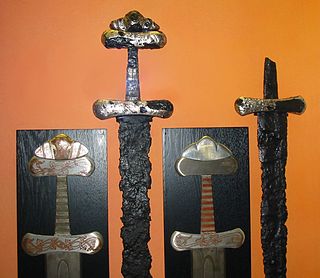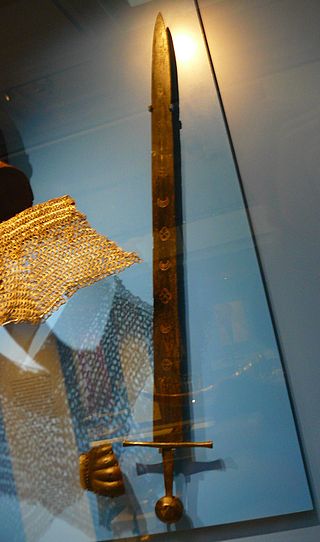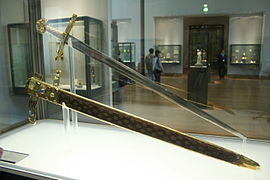A sword is an edged, bladed weapon intended for manual cutting or thrusting. Its blade, longer than a knife or dagger, is attached to a hilt and can be straight or curved. A thrusting sword tends to have a straighter blade with a pointed tip. A slashing sword is more likely to be curved and to have a sharpened cutting edge on one or both sides of the blade. Many swords are designed for both thrusting and slashing. The precise definition of a sword varies by historical epoch and geographic region.

Szczerbiec is the ceremonial sword used in the coronations of most Polish monarchs from 1320 to 1764. It now is displayed in the treasure vault of the royal Wawel Castle in Kraków, as the only preserved part of the medieval Polish crown jewels. The sword is noted for its hilt, decorated with magical formulae, Christian symbols, and floral patterns, as well as for the narrow slit in the blade which holds a small shield with the coat of arms of Poland. The name of the sword is derived from the Polish word szczerba, and its meaning is incorrectly perceived as "the Notched Sword" or "the Jagged Sword", though the edges of its blade are straight and smooth. Proper meaning and rendering into English would be "the Notching/Jagging Sword" — as "a sword that is meant to notch/jag other weapons".

The Song of Roland is an 11th-century chanson de geste based on the deeds of the Frankish military leader Roland at the Battle of Roncevaux Pass in AD 778, during the reign of the Emperor Charlemagne. It is the oldest surviving major work of French literature. It exists in various manuscript versions, which testify to its enormous and enduring popularity in Medieval and Renaissance literature from the 12th to 16th centuries.

The chanson de geste is a medieval narrative, a type of epic poem that appears at the dawn of French literature. The earliest known poems of this genre date from the late 11th and early 12th centuries, shortly before the emergence of the lyric poetry of the troubadours and trouvères, and the earliest verse romances. They reached their highest point of acceptance in the period 1150–1250.

Ogier the Dane is a legendary paladin of Charlemagne who appears in many Old French chansons de geste. In particular, he features as the protagonist in La Chevalerie Ogier, which belongs to the Geste de Doon de Mayence. The first part of this epic, the enfance[s] of Ogier, is marked by his duel against a Saracen from whom he obtains the sword Cortain, followed by victory over another Saracen opponent from whom he wins the horse Broiefort. In subsequent parts, Ogier turns into a rebel with cause, seeking refuge with the King of Lombardy and warring with Charlemagne for many years, until he is eventually reconciled when a dire need for him emerges after another Saracen incursion.

The French Crown Jewels and Regalia comprise the crowns, orb, sceptres, diadems and jewels that were symbols of Royal or Imperial power between 752 and 1870. These were worn by many Kings and Queens of France as well as Emperor Napoleon. The set was finally broken up, with most of it sold off in 1885 by the Third Republic. The surviving French Crown Jewels, principally a set of historic crowns, diadems and parures, are mainly on display in the Galerie d'Apollon of the Louvre, France's premier museum and former royal palace, together with the Regent Diamond, the Sancy Diamond and the 105-carat (21.0 g) Côte-de-Bretagne red spinel, carved into the form of a dragon. In addition, some gemstones and jewels are on display in the Treasury vault of the Mineralogy gallery in the National Museum of Natural History.

Durendal, also spelled Durandal, is the sword of Roland, a legendary paladin and partially historical officer of Charlemagne in French epic literature. The sword is famous for its hardness and sharpness. Sources including La Chanson de Roland state that it first belonged to the young Charlemagne.
Curtana, also known as the Sword of Mercy, is a ceremonial sword used at the coronation of British kings and queens. One of the Crown Jewels of the United Kingdom, its end is blunt and squared to symbolise mercy.

The Viking Age sword or Carolingian sword is the type of sword prevalent in Western and Northern Europe during the Early Middle Ages.

Oliver, sometimes referred to as Olivier de Vienne or de Gennes, is a legendary knight in the Matter of France chansons de geste, especially the French epic The Song of Roland. In the tradition, he was Roland's closest friend, advisor, confidant and brother-in-law to be, one of Charlemagne's twelve peers and brother of Aude, Roland's betrothed. He dies with Roland at the Battle of Roncevaux Pass. Some critics have linked his name to the olive tree, a biblical symbol of divine wisdom.

A kalis is a type of Philippine sword. The kalis has a double-edged blade, which is commonly straight from the tip but wavy near the handle. Kalis exists in several variants, either with a fully straight or fully wavy blade. It is similar to the Javanese keris, but differs in that the kalis is a sword, not a dagger. It is much larger than the keris and has a straight or slightly curved hilt, making it a primarily heavy slashing weapon.

The Wallace Sword is an antique two-handed sword purported to have belonged to William Wallace (1270–1305), a Scottish knight who led a resistance to the English occupation of Scotland during the First War of Scottish Independence. It is said to have been used by William Wallace at the Battle of Stirling Bridge in 1297 and the Battle of Falkirk (1298).

The Imperial Sword is one of the four most important parts of the Imperial Regalia (Reichskleinodien) of the Holy Roman Empire. During a coronation, it was given to the emperor along with the Imperial Crown (Reichskrone), Imperial Sceptre (Reichszepter), and the Imperial Orb (Reichsapfel). All four parts of the Imperial Regalia are displayed in the Imperial Treasury at the Hofburg Palace in Vienna, Austria. It is also known as Mauritiusschwert, or the sword of Saint Maurice.

The Paladins, also called the Twelve Peers, are twelve legendary knights, the foremost members of Charlemagne's court in the 8th century. They first appear in the medieval chanson de geste cycle of the Matter of France, where they play a similar role to the Knights of the Round Table in Arthurian romance. In these romantic portrayals, the chivalric paladins represent Christianity against a Saracen (Muslim) invasion of Europe. The names of the paladins vary between sources, but there are always twelve of them led by Roland. The paladins' most influential appearance is in The Song of Roland, written between 1050 and 1115, which narrates the heroic death of Roland at the Battle of Roncevaux Pass.

The barong is a thick, leaf-shaped, single-edged blade sword. It is a weapon used by Muslim Filipino ethnolinguistic groups like the Tausug, Sama-Bajau, or Yakan in the Southern Philippines.
Murgleys, or Murgleis is the sword of Ganelon, a traitorous French (Frankish) count and nemesis to the titular hero of the epic La chanson de Roland.

In the European High Middle Ages, the typical sword was a straight, double-edged weapon with a single-handed, cruciform hilt and a blade length of about 70 to 80 centimetres. This type is frequently depicted in period artwork, and numerous examples have been preserved archaeologically.
Cortain is a legendary short sword in the legend of Ogier the Dane. This name is the accusative case declension of Old French corte, meaning "short".
The Treasury of Saint-Denis, kept at the Basilica of Saint-Denis in Paris until the French Revolution, was the main repository of the regalia of the Kingdom of France, including the ancien régime portion of what are now known as the French Crown Jewels. Its surviving items are presently scattered between the Louvre, the Cabinet des Médailles of the French National Library, and other museums.

The rich iconography of Charlemagne is a reflection of Charlemagne's special position in Europe's collective memory, as the greatest of the Frankish kings, founder of the Holy Roman Empire, unifier of Western Europe, protector of the Catholic Church, promoter of education and of the Carolingian Renaissance, fictional precursor of the crusades, one of the Nine Worthies, a (contested) Catholic saint, and a national icon in Andorra, Belgium, France, Germany, Italy, Netherlands and Switzerland.






















